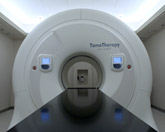 TomoTherapy combines advanced diagnostic imaging with unprecedented treatment efficiency, precision and safety. For cancer patients, it means faster, more effective treatment with fewer side effects than with conventional radiation therapy.
TomoTherapy combines advanced diagnostic imaging with unprecedented treatment efficiency, precision and safety. For cancer patients, it means faster, more effective treatment with fewer side effects than with conventional radiation therapy.
TomoTherapy has the potential to treat cancers in challenging areas, such as brain cancer and malignancies that grow close to the spine or other critical areas.
TomoTherapy Offers Unprecedented Precision
TomoTherapy is a refinement of Intensity Modulated Radiation Therapy, or IMRT. During treatment, patients lie on a table that moves through a ring-shaped tunnel. At the same time, a linear accelerator (the radiation source) moves in an arc through the ring. The result is a unique spiral pattern that increases the number of angles at which radiation enters the body. That translates into improved ability to avoid critical organs — plus less radiation along any particular angle.
TomoTherapy's precision allows clinicians to deliver high doses of radiation extremely efficiently, sparing healthy tissue and shortening each treatment from 30 minutes to five minutes.
A second advantage of TomoTherapy is its use of computed tomography (CT) to obtain moment-to-moment images of tumors immediately before or after treatment. Conventional radiation therapy relies on an image of a patient's tumor taken days or even weeks before treatment begins. But tumors can change and grow quickly; and some, such as those in the prostate gland and parts of the body affected by breathing motion, tend to be moving targets, reducing image reliability. By incorporating CT technology into the system, TomoTherapy allows clinicians to immediately verify the location of tumors and nearby organs.
TomoTherapy makes radiation therapy available to patients who would not otherwise be candidates, including those who have undergone radiation therapy once but whose cancers have returned, and patients with skull base tumors that are too large to be treated with Gamma Knife.